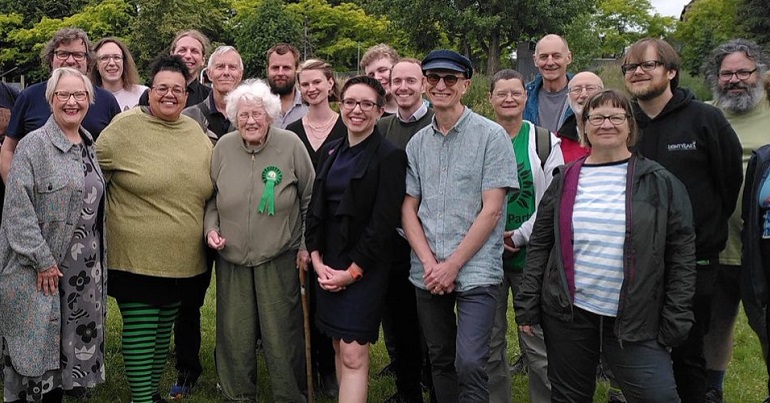How digital democracy can boost political engagement

- Part of Bright Green’s new political engagement series
This isn’t a great time to be on the left. There can be no denying that with Labour’s self-destruction, the right are in the ascendency. However, this presents an opportunity: smaller parties must step up to the breach. One way this can be done is by harnessing modern technology: digital democracy can help smaller parties breakthrough.
Getting young people out to vote can be the key to a left revival, something that can be achieved by embracing digital democracy. Anyone, who is active on Twitter has seen the number of political tweeters: indeed, many will have bemoaned ‘keyboard warriors’ at one time or another (I certainly have). Most recently, the Labour split showcased this, as the ‘we are his media’ hashtag exploded with support for Jeremy Corbyn. Alongside this support, we saw Corbyn opponents complaining Corbyn’s supporters had, ‘never done anything for the Labour party’ and should be on the doorstep instead of tweeting their support. What if these people, using their online voice, could be harnessed? What if the keyboard warriors could become contributing political activists?
There are numerous barriers to political engagement, ranging from anxiety preventing people knocking on doors, to prohibitive travel costs preventing people attending political conferences, to schedules preventing people committing their time. Everyone, no matter the barrier to their involvement, has something to say and something to contribute. In the long term, it is imperative that we move toward digital democracy in our national electoral process: this is the only way to abate what is a fairly consistent trend of falling turnout. Obviously, it is also essential that we move toward a more proportional and representative voting system, but this alone may not be enough to encourage engagement.
More immediately, internal digital democracy offers hope for smaller parties to challenge the two party system, this, in turn, will put electoral change on the agenda. The possibility for digital democracy, and the impact of social media, has already been shown by parties of the right. The best example of this is Britain First, who, via their Facebook campaigning, have risen to prominence. Though their publicity has not been rewarded with electoral success, they have succeeded, alongside others such as Ukip, in fundamentally shifting the debate on issues such as immigration. Britain First have acted mostly as a pressure group; however, a committed political party using similar tactics, to less repellent ends, could make great strides.
As already mentioned, young people are less likely to be politically engaged. Lack of engagement is primarily caused by the feeling that voices aren’t listened to. Next month, I will attend Green Party conference, this will allow me to vote on policy, and therefore, will ensure I have a say; smaller parties should look to extend this right to all members, whether they can attend conferences or not. This can be achieved via a system of online policy submission and member voting. Not only would this enable parties to make democratic decisions more efficiently, and thus, to respond to issues as they arise; it would also enable small parties to gain wider appeal, as every one of those activists on social media, those people with an opinion but no voice, can be empowered and given a voice. This would manifest itself in greater representation on the streets; members, given a say in policy development, are likely to feel more connected to the party, and therefore, to have greater desire to campaign.
In making people feel more connected to their party, and thus motivating them to spread the word and gain support for that party, digital democracy can be the tool which allows smaller parties to truly breakthrough. One of the issues facing smaller parties is a failure to make effective use of their members. This can only be blamed on failures of internal organisation and greater use of digital communication can help to solve this issue. For example, a problem faced by The Green Party is the frequency of membership lapses, this being the scenario where members are unaware that their membership has, in fact, expired. This occurs due to the lack of reminders; famously, London mayoral candidate Sian Berry suffered a membership lapse, leaving her ineligible to stand for leader.
By improving internal systems, and embracing internal digital democracy, smaller parties can begin to make inroads in elections; for example, they can coordinate more effectively with activists to ensure their limited resources are focused in the right places. This can help to get more activists spreading their message in key areas. Further, videos, taken while campaigning, can be used so that evidence of campaigns floods social media; this means that each act of campaigning can have an impact beyond the space in which it happened. It also enables those unable to campaign, in person, to play their part.
At the last election, we saw the vote-swap site which sought to help members vote tactically for the candidate with the best chance of beating the local Conservative parliamentary candidate. Now I don’t particularly like tactical voting, it allows the larger parties to feel entitled to votes. However, in practical terms, the best hope of avoiding a Conservative government in 2020 lies in forming a progressive alliance. While this now looks unlikely, given the recent comments of Mr Corbyn that Labour will be standing against the Greens, even in Brighton Pavilion; if it were to happen, the best way to communicate the details would be online. Smaller parties have been largely excluded from traditional media sources, this limits their ability to get their message out. In the past, with party election broadcasts, smaller parties have seen many of their views coming online. Capitalising on online video sharing can help smaller parties get their message out more clearly, helping cut through the scaremongering that would, inevitably, follow the announcement of a progressive alliance.
So what’s to be done? Well, as previously stated, smaller parties need to begin to offer a chance for all members to create and vote on policy online; simultaneously, smaller parties should strive to improve accountability by allowing members the opportunity to regularly hold party executives to account online; further, parties should use social media to ensure that members are aware of events and opportunities to campaign, they should also utilise online video sharing to ensure evidence of their campaigns is widely spread; Finally, smaller parties should look to utilise a central online site to ensure internal communications can be easily coordinated.
In truth, digital democracy can be the leveller, there are far fewer barriers involved with internet campaigning than there are with the traditional mediums. Digital democracy can be the thing that allows the smaller parties to breakthrough, helping them to get their message out to the public, and it can help them get their members out to the streets.
If you would be interested in contributing to this article series on political engagement please email allsopbradley@gmail.com with an article pitch




Excellent article. I’d only add that we have to be careful how good ideas, like Vote Swap, can be manipulated and hijacked. It became apparent that any constituency named a Labour marginal would lead to Green voters being advised Labour. Even our constituency with a very high conservative margin became a ‘marginal’. The Labour Party advised my voters in Finchley and Golders Green that I wanted them to vote Labour instead of for me (I didn’t) and to check with Vote Swap. It lost a lot of Green Party deposits so I hope we make that clear next time. Other good groups that gather a large following on Facebook etc or to sign petitions also get hijacked by a political party. Although they are set up to be non-part-political, it’s a standard type of aggressive online marketing to let somebody else do all the hard work gathering a large number of people and then recruiting them. Typically this would be saying ‘only this one party is fighting to stay in the EU’ in a Facebook group of Remainers, while discrediting other parties that are also pro-Remain. During an election they will typically say that only one party has a chance of being voted in to achieve the aims of the group – even if they aren’t the best party for that group. Saving the NHS was used in this way during the election. People can get to high admin levels in influential online groups that are supposedly non-party-political. So I think we have to raise awareness that the ability to reach a huge number of people online can be a two-edged sword.
Sorry there, not their!!
I will always vote Green if their is a candidate standing, while Corbyn has some good policies the labour party nwill never!! be for me & anyhow I am not very left wing however I dislike the Selfservative CONS & Ukip even more or all fascists.
“However, in practical terms, the best hope of avoiding a Conservative government in 2020 lies in forming a progressive alliance.”
I keep hearing this but I see no evidence and suspect it is wishful thinking. The best way to defeat the Tories is to replace the Labour party with a more credible alternative.
Otherwise a useful reminder that technology can and should be driving a different type of politicAl engagement. I would live to hear some practical ideas about how to do this